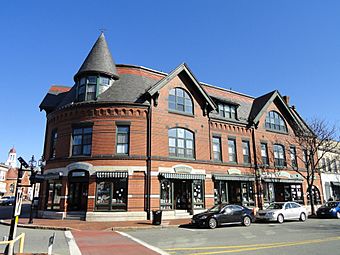Winchester Center Historic District facts for kids
Quick facts for kids |
|
|
Winchester Center Historic District
|
|

Book Ends
|
|
| Location | Winchester, Massachusetts |
|---|---|
| Area | 40 acres (16 ha) |
| Architect | Coit, Robert; Fletcher, Asa |
| Architectural style | Late 19th And 20th Century Revivals, Late Victorian |
| NRHP reference No. | 86002943 |
| Added to NRHP | November 21, 1986 |
The Winchester Center Historic District is a special area in Winchester, Massachusetts. It covers the main business and public parts of the town. This district is roughly located between Mt. Vernon and Washington Streets, Waterfield Road, and Church and Main Streets.
You can find many buildings here built in the Romanesque Revival style. These include the Winchester Town Hall and the Winchester Savings Bank building. Famous architects like Robert Coit and Asa Fletcher helped design some of these buildings. The district was added to the National Register of Historic Places in 1986. This means it's an important place in history.
Contents
What Makes Winchester Center Special?
The Winchester Center Historic District is like a living museum. It shows how the town grew over time. It has many buildings that are important for their history and design.
A Look at Old Buildings
Many buildings in the district show a style called Romanesque Revival. This style uses ideas from old Roman buildings. Think of strong, round arches and solid stone. The Winchester Town Hall, built in 1887, is a great example. Another is the Brown and Stanton Block from 1879.
Later, in the early 1900s, new styles appeared. The Lincoln School (1903) was built in the Beaux Arts style. The Police and Fire Station (1914) shows the Colonial Revival style. The library, built in 1931, is in the Gothic Revival style. Local architect Robert Coit designed the library.
How Winchester Center Grew
The area that is now Winchester was first settled in the 1640s. It was known as South Woburn back then. The town center started around a grist mill and a bridge over the Aberjona River. A grist mill is a place where grain is ground into flour.
For a long time, the community was mostly about farming. But things changed a lot in 1835. That's when the Boston and Lowell Railroad was built through the area. The railroad helped the town grow quickly. It made the village center much busier.
In 1850, Winchester became its own town, separate from Woburn. The center then became the main place for town government and churches. The First Congregational Church was built here in 1854.
Changes Over Time
One big change to the district was when the Boston and Lowell train tracks were raised. This change split the district into two parts. Even with changes, the Winchester Center Historic District still keeps its old charm. It helps us remember the town's past.



